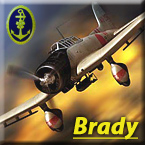Brady
Posts: 10701
Joined: 10/25/2002
From: Oregon,USA
Status: offline

|
The following is a very general aproach to explaing these planes, this is not a flight sim so I will not expound, and UV and WiTP handel these planes in a very abstract maner, and many of the plane types are generic in the game, also in UV they have the Ki-84C which never realy produced in any number (it has the 30mm Cannons).
Tony (Ki-61), Early models went into action in New Gunie, whear it proved a very formadable aponet for the Allies, superiour to al but the P38 in most respects, early Models had the MG 151, but later ones switched to the better Japanese Ho-5 20mm Cannon, no mater the time of war the Ki-61 is a good machine, though Early models were the best preforming generaly, specificaly in terms of climb rate. They even I beleave out climbed the Ki-44 at least the early models did.
Ki-44, Another good Army fighter, though not as well rounded as the Tony, the Tony handeled better, it's 40 mm cannon was useless (the modles that had it). Generaly speaking a good climber, but by the time the Ki-84 was coming in to service the Frank was defenatly the better machine.
Ki-84, Superlative aircraft, as noted above likely the Best of the Japanese Army Machines, it was a good designe, post war tests under ideal condations with US fuel produced some stagering results, it out preformed a P51D, and a P47N ( prety shure it was a N).
Ki-45, Ground atack and Bomber intercept, good PT Boat killer as well.
.....................
Jack/George - Navy land based interceptor, offered good climb rates and Good forepower, two 20 Type 99MK I and two 20 MM Type 99 MK II cannon, production delays slowed it introduction to the front and by the time they were largely iroedout the George was intering service, the N1K1 (George) was the Better machine by far, initialy Georges suffered a number of Mechanical bugs, and the Mid wing N1K1 was part of the problem that and it's long landing gear, these probles and others were ironed out and the result was the N1K2 preformance wise almost identical to the N1K1, it was an excelent fighter, the best the Navy had during the late war, it had the same engine as the Ki-84 though it was a bit slower. The George also incourperated a noval automated flap system which gave it superlative handeling qualitys.
|
 Printable Version
Printable Version

















 New Messages
New Messages No New Messages
No New Messages Hot Topic w/ New Messages
Hot Topic w/ New Messages Hot Topic w/o New Messages
Hot Topic w/o New Messages Locked w/ New Messages
Locked w/ New Messages Locked w/o New Messages
Locked w/o New Messages Post New Thread
Post New Thread